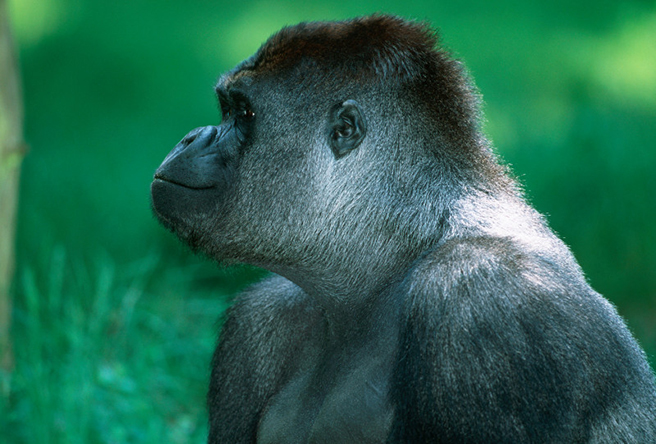Meeting the Western Lowland Gorillas

The mountain gorillas of the Virungas are often described as living in a giant salad bowl. The lowland gorillas also live in the midst of their favorite food source—the broad-leafed marantaceae scrub.
After four hours of tough trekking, our safari group, comprised of AWF trustees and myself, suddenly came upon the group we were seeking. The silverback gorilla named Neptuno was sitting on the ground perhaps 15 meters from us. A mature female was lying on the ground nearby with two youngsters while other gorillas played in the trees above.
Lowland gorillas are slightly smaller and lighter than their mountain cousins, but you would never know it from meeting Neptuno. He is a huge, fully grown male, with a well-developed saddle of silver extending from his head down to his back and thighs. Like all fathers, Neptuno looks for those few moments of peace and quiet when the juveniles aren’t rambunctious or when the demands of being the de facto leader of the group don’t weigh on him.
I suspect we arrived at such a moment when Neptuno was looking for solitude and rest.
Yet, for all his efforts, this wasn’t something he could achieve. A large female sought his attention and used our presence to get a rise out of her mate. While he tried to rest, she flirtatiously edged closer to us, as if to show interest in our group. Neptuno ignored her—and us—at first, but a guy can only take so much provocation. He suddenly exploded out of his resting position and came toward us with hoots and grunts, making it very clear that any challenge to his primacy was not welcome. Interestingly, he did not charge us straight on, but rather cut a diagonal path across the front of our group so that we received the full brunt of his display without the danger of actual physical confrontation.
Apparently, chastened and satisfied that he was willing to protect her, the female fell back in the family group, and we continued to observe the fascinating behavior of the group for the full hour permitted by conservation guidelines.
Even with the expert services and hospitality of Wilderness Safaris, a trip to Odzala National Park in Congo is certainly a little more challenging than a usual safari to East or Southern Africa. Some portions of the humid jungle hike were very difficult and occasionally required our guides to cut a path through the extremely dense under-vegetation. We were also issued head nets to protect against small annoying sweat bees who stay close to the gorillas, but who were not averse to moving their attention to other large primates when we were around.
By the end of the safari, it became commonplace at brunch to roll up pant legs or shirtsleeves in order to compare various insect bites and to see whose limbs were the most swollen.
But all of this was a small price to pay for the privilege of seeing lowland gorillas in the wild—and being in the beautiful jungles of Congo.
